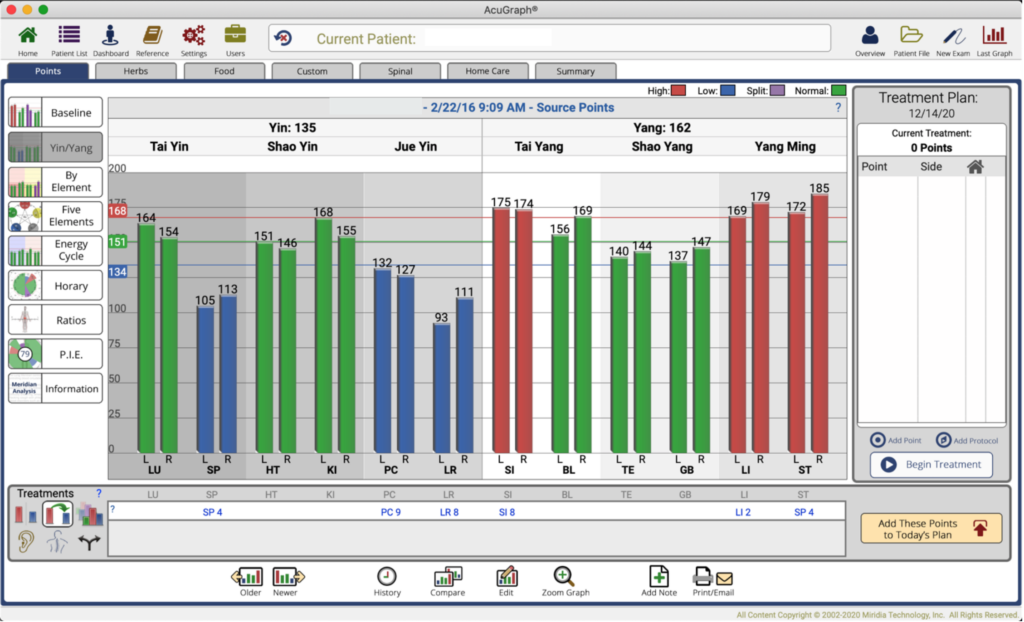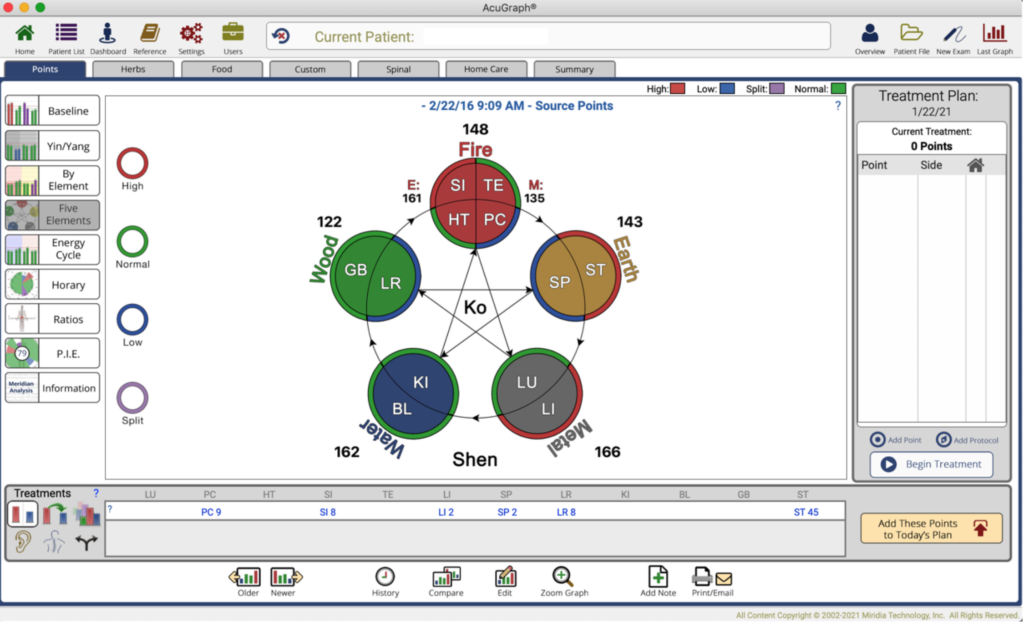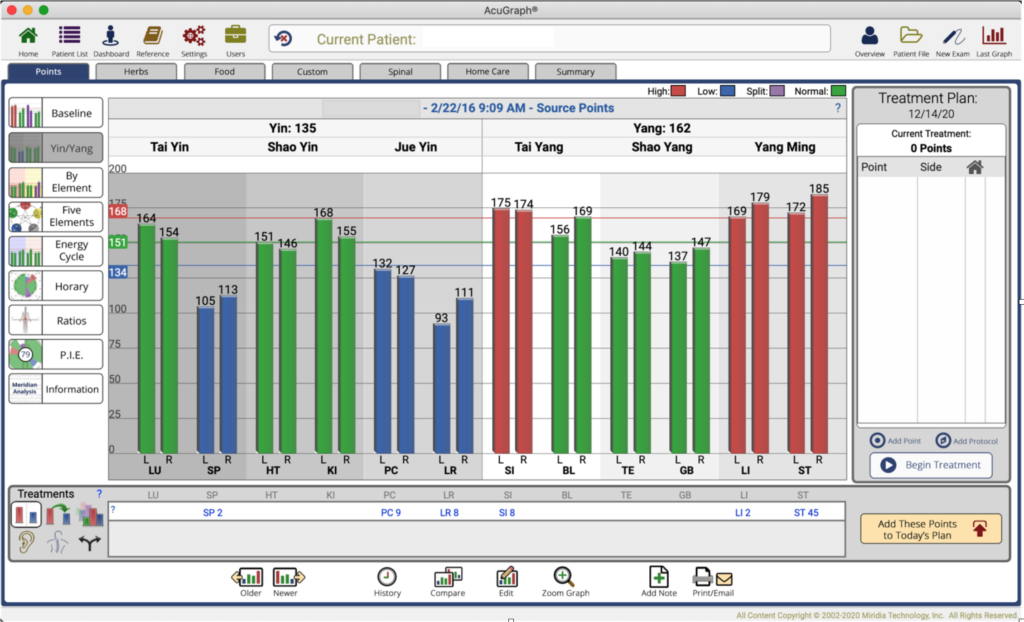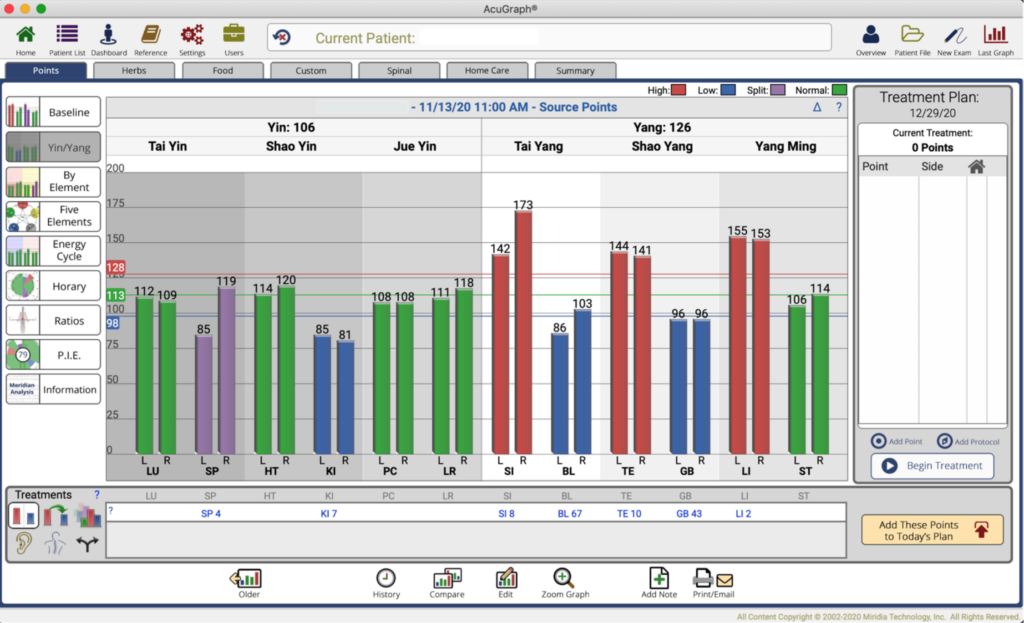
Other Posts in this Series
To read parts 1, 2 or 3 of The Primary Channel Balance series, click the links below:
- Part 1: The Primary Channel Balance
- Part 2: Modern Japanese and Chinese Approaches to Balancing Acupuncture Meridians
- Part 3: The Taiji Balancing Method
Part 4: Treatment Examples
This is Part 4 of The Primary Channel Balance by Dr. Jake Fratkin. Reading parts 1, 2 and 3 will offer context. You can navigate to parts 1, 2 and 3 in the “Other Posts in this Series” section above this paragraph.
In the first three parts of this series, we looked at several meridian channel balance approaches. In today’s post, we’ll apply what we’ve learned with some actual treatment examples.
Treatment Example 1.

The above screen is in the Yin/Yang graph, allowing us to determine the Primary Pattern of the six yin channels, on left side. We see that SP, PC, and LR are all blue, meaning deficient. Which blue represents the primary? Imagine the 5-Element sequence, going clockwise.

The order would be LR, PC, SP. (In this chart, PC is called Circulation/Sex). We look for any two that will be adjacent to each other (mother and child). LR and PC are adjacent, but so is PC and SP. SP is the most clockwise blue on the yin channels, and its mother (PC) is also blue, so SP is the primary. Had SP not shown, but instead LU did, then PC would be the primary. (Classical Keiraku Chiryo does not recognize HT or PC as primary patterns, but I do, based on clinical practice.) Now that we know SP is the primary pattern, we want to make sure it is tonified in our treatment.

If I choose to simplify and use ion-pumping cords, I would make sure to treat the KC primary, which is SP. Looking at our Taiji Balancing Method Chart (below), I would go to the SP column on the left, and then see if any of the point recommendations in the 6 columns to the right are particularly excess. To this end we see that 3 of our groups offer a red excess: SI (#2), ST (#3), and LI (#6). Which one to choose? For one thing, degree of excess is important, and in that regard right sides of both ST and LI are the higher. Additionally, LI fulfills Manaka’s priority. So, either one would work, and would be the channel that is sedated (black clip) while SP receives the tonification end of the ion-pumping cord (red clip).
In addition, I would tonify LR on the left side, because it is significantly low. I would ignore PC and SI because they are only slightly out of normal range. And in this case, I look at my Taiji Balancing Method chart, trying to find what could balance out left side LR. Either the excess on SI (#4) or the excess on LI (#2) will work. To balance, I can mix left and right sides, if necessary, with my ion-pumping cord. But in this case the red excess of LI and SI are not particularly excessive. It would just as well work to go with tonifying LR on the left side with the AcuGraph menu recommendation, LR 8, and not bother with another cord.
Case #2.

Here is a simple case. The P.I.E. score was 60. If we look at the Yin/Yang graph, we have one meridian, KI, in blue. SP is also showing deficient on the left side. So, we can say that KI is the primary. It can be treated in isolation with its tonification point, or we use ion-pumping cords to feed in one of the excess yang channels. There, our choices in red are SI, TE, and LI. Looking then at the Taiji Balancing Method chart, to KI in the furthermost left column, we find as available partners: SI (#6), TE (#2), and LI (#4). We could use any of these to tonify KI. My preference would be for Manaka’s 3-Group recommendation, SI, and a second choice would be Chinese clock opposite, LI.
Having included that, I also would tonify SP on the left side. We can do this in isolation, with a SP tonification point, or we could attach by ion-pumping cord to SI (#2), TE (#4), or LI (#6). Since we have chosen SI to balance KI, then we can choose TE or LI. The tonification would happen on the left side, which is the deficient side on the SP channel.
In general, I like to cross the body when moving an excess into a deficiency.
In conclusion, proper Meridian Balancing should prioritize which deficient and which excess channels to treat. Concentrate on the primary according to Keiraku Chiryo, but also seek to return to normal the most extreme excess(s) and the most extreme deficient(s). When the qi is of good quality, and can run unobstructed through the channels in their natural sequence, health and well-being are restored.
I hope this article was helpful. Thanks for reading!
Other Posts in this Series
To read parts 1, 2 or 3 of The Primary Channel Balance series, click the links below:
- Part 1: The Primary Channel Balance
- Part 2: Modern Japanese and Chinese Approaches to Balancing Acupuncture Meridians
- Part 3: The Taiji Balancing Method

Save $300 on AcuGraph through Thursday, July 22, 2021!
AcuGraph is an invaluable tool when it comes to balancing the acupuncture channels. It’s the tool recommended and endorsed by Dr. Fratkin, and is integral to his methods and success.
To help you implement everything you’re leaning in Dr. Fratkin’s blog series, you can get $300 off the AcuGraph Practice Builder package through July 22, 2021!
Click Here to Learn more about AcuGraph >>
Save $300 on the AcuGraph Practice Builder Package >>

Jake Paul Fratkin, OMD, L.Ac. trained in Korean and Japanese acupuncture since 1975, and Chinese herbal medicine since 1982. He is the author of Essential Chinese Formulas (2014), and Chinese Herbal Patent Medicines, The Clinical Desk Reference (2001). Jake practices in Boulder, Colorado, where he specializes in internal disorders, infections, and pediatrics.
Would knowing the clinical signs of deficiancy and excess help in these instances? Which points are are we tonifying or sedation? hrb
I don’t take into account or relate symptoms to channel selection. I rely on the AcuGraph visual representation of excess and deficiencies. My goal is to balance the channels. Reliance on symptoms can be misleading. – Jake Fratkin